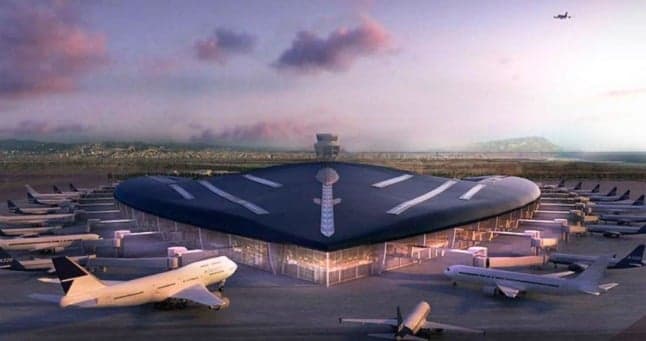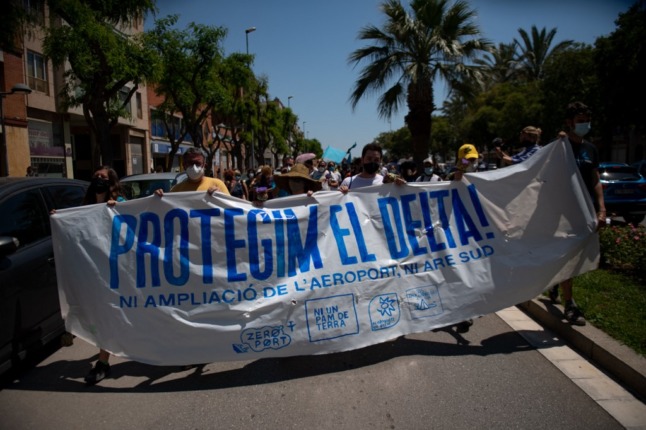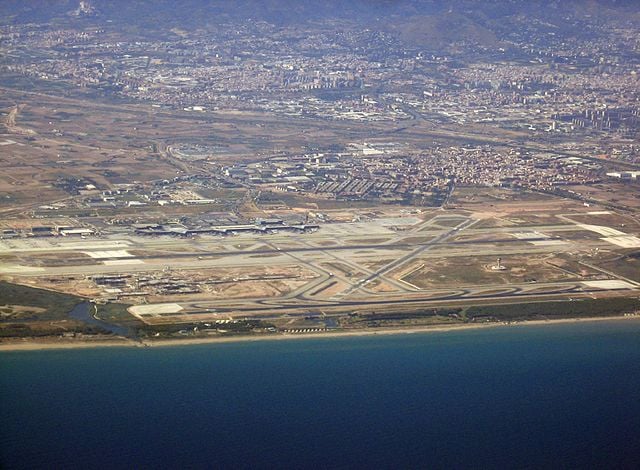Six things you need to know about Barcelona airport's €1.7 billion planned expansion

Barcelona's controversial airport expansion project has currently been put on hold because of differences between Catalan authorities and Spain’s national government. But, if plans do go ahead, here's everything you need to know about a project that aims to transform Spain's second airport into a major international hub.
€1.7 billion investment
Catalonia’s Generalitat and Spain’s national government agreed in August that the €1.7 billion figure proposed by the country’s airport operator AENA will be invested into the expansion of Josep Tarradellas El Prat, the Catalan capital’s main airport.
The government led by Pedro Sánchez also announced it would invest €1.6 billion in Madrid’s Barajas Adolfo Suárez airport.
These vast sums of money form part of the €140 billion Spain will receive from the EU’s coronavirus recovery fund, meaning that they still need full approval by the European Commission (EC) to go ahead with the revamp.
However, in mid-September Catalan leader Pere Aragonès and his government said they did not want the project to affect the nearby wetlands and La Ricarda Lagoon. This caused differences between Spain's national government and the Catalan authorities, meaning that the expansion project has currently been put on hold.
Major hub
The expansion is a multifaceted project but the main aim is to transform Barcelona’s El Prat into a major airport hub for long-haul international flights, one that can compete with the likes of Dubai, Singapore or Heathrow.
One of the key targets is to improve flight connections with America and Asia and for El Prat to become one of Europe’s main hubs connecting both continents.
As Catalan vicepresident Jordi Puigneró put it, El Prat should go from “being a low-cost airport to a value-added airport”.
"One of the great problems that the Catalan economy has today is that when it comes to travel to other parts of the world, passengers very often have to make stopovers, so we lose competitiveness," Puigneró argued about the lack of direct international flights to Barcelona.
Aena has already invested €48 million in 2021 to readapt El Prat’s Terminal 1 for it to be able to house larger long-haul aircraft such as the Airbus A380.
In 2019, Barcelona-El Prat received 52.7 million passengers, only behind Madrid's 61.7 million.
If given the green light by the European Commission, El Prat's expansion will begin in 2022.
 Render showing what El Prat's new satellite terminal will look like. Image: Aena
Render showing what El Prat's new satellite terminal will look like. Image: Aena
Connecting Catalan airports
El Prat’s planned expansion will bring with it high-speed rail connections to the region’s two other main airports: Reus (Tarragona) and Girona.
Once completed, it will reportedly take just 30 minutes by train to reach either airport from El Prat, a scheme which will boost flights leaving from these smaller airports whilst also decongesting air traffic at El Prat.
Plenty of jobs
According to the Spanish government, El Prat’s revamp will create 85,000 jobs directly and 365,000 indirectly.
It will also reportedly increase Catalonia’s GDP by 2.1 points.
‘The greenest in Europe’
During a radio interview following the agreement reached between both governments, Catalan vicepresident Jordi Puigneró proposed that Barcelona-El Prat become “the greenest airport in Europe”.
"New types of fuels will be released and we will be able to make decisions about what type of aircraft we want to land at El Prat," Puigneró argued, adding that reducing the carbon intensity for mobility around the airport should also be a goal.
"We must do everything possible so that this airport ends up being better than the one we have now."
New satellite terminal and runway may not be so green
One of the project’s main features, the construction of a satellite terminal to support the extension of El Prat’s third runway by 500 metres, will encroach on the protected space of La Ricarda.
Environmentalists and neighbouring municipalities oppose this expansion for the environmental impact and noise pollution it could cause, and there’s reason to believe this could be a stumbling block for a project that requires EU approval.

People hold a banner reading "Protect the delta" during a demonstration against the construction of a third runway at the Barcelona airport in El Prat de Llobregat, near Barcelona, on June 12, 2021. (Photo by Josep LAGO / AFP)
European Commissioner for Environment Virginijus Sinkevicius has already warned that before the expansion “can go ahead, it’s necessary to address the existing deficiencies” in the Llobregat Delta, for which the EC has opened two infringement procedures against Spain.
Barcelona mayor Ada Colau is also against the enlargement of a runway if it affects the protected area.
Spain’s national government initially proposed to increase the runway and satellite terminal area by 1,091 hectares, but Aena has since announced only 45 hectares of La Ricarda would be used, in return promising to protect 280 hectares of the Llobregat Delta.

Aerial shot showing El Prat airport's runways and airport next to the Llobregat Delta. Photo: unknown/Wikipedia
Comments
See Also
€1.7 billion investment
Catalonia’s Generalitat and Spain’s national government agreed in August that the €1.7 billion figure proposed by the country’s airport operator AENA will be invested into the expansion of Josep Tarradellas El Prat, the Catalan capital’s main airport.
The government led by Pedro Sánchez also announced it would invest €1.6 billion in Madrid’s Barajas Adolfo Suárez airport.
These vast sums of money form part of the €140 billion Spain will receive from the EU’s coronavirus recovery fund, meaning that they still need full approval by the European Commission (EC) to go ahead with the revamp.
However, in mid-September Catalan leader Pere Aragonès and his government said they did not want the project to affect the nearby wetlands and La Ricarda Lagoon. This caused differences between Spain's national government and the Catalan authorities, meaning that the expansion project has currently been put on hold.
Major hub
The expansion is a multifaceted project but the main aim is to transform Barcelona’s El Prat into a major airport hub for long-haul international flights, one that can compete with the likes of Dubai, Singapore or Heathrow.
One of the key targets is to improve flight connections with America and Asia and for El Prat to become one of Europe’s main hubs connecting both continents.
As Catalan vicepresident Jordi Puigneró put it, El Prat should go from “being a low-cost airport to a value-added airport”.
"One of the great problems that the Catalan economy has today is that when it comes to travel to other parts of the world, passengers very often have to make stopovers, so we lose competitiveness," Puigneró argued about the lack of direct international flights to Barcelona.
Aena has already invested €48 million in 2021 to readapt El Prat’s Terminal 1 for it to be able to house larger long-haul aircraft such as the Airbus A380.
In 2019, Barcelona-El Prat received 52.7 million passengers, only behind Madrid's 61.7 million.
If given the green light by the European Commission, El Prat's expansion will begin in 2022.
 Render showing what El Prat's new satellite terminal will look like. Image: Aena
Render showing what El Prat's new satellite terminal will look like. Image: Aena
Connecting Catalan airports
El Prat’s planned expansion will bring with it high-speed rail connections to the region’s two other main airports: Reus (Tarragona) and Girona.
Once completed, it will reportedly take just 30 minutes by train to reach either airport from El Prat, a scheme which will boost flights leaving from these smaller airports whilst also decongesting air traffic at El Prat.
Plenty of jobs
According to the Spanish government, El Prat’s revamp will create 85,000 jobs directly and 365,000 indirectly.
It will also reportedly increase Catalonia’s GDP by 2.1 points.
‘The greenest in Europe’
During a radio interview following the agreement reached between both governments, Catalan vicepresident Jordi Puigneró proposed that Barcelona-El Prat become “the greenest airport in Europe”.
"New types of fuels will be released and we will be able to make decisions about what type of aircraft we want to land at El Prat," Puigneró argued, adding that reducing the carbon intensity for mobility around the airport should also be a goal.
"We must do everything possible so that this airport ends up being better than the one we have now."
New satellite terminal and runway may not be so green
One of the project’s main features, the construction of a satellite terminal to support the extension of El Prat’s third runway by 500 metres, will encroach on the protected space of La Ricarda.
Environmentalists and neighbouring municipalities oppose this expansion for the environmental impact and noise pollution it could cause, and there’s reason to believe this could be a stumbling block for a project that requires EU approval.

People hold a banner reading "Protect the delta" during a demonstration against the construction of a third runway at the Barcelona airport in El Prat de Llobregat, near Barcelona, on June 12, 2021. (Photo by Josep LAGO / AFP)
European Commissioner for Environment Virginijus Sinkevicius has already warned that before the expansion “can go ahead, it’s necessary to address the existing deficiencies” in the Llobregat Delta, for which the EC has opened two infringement procedures against Spain.
Barcelona mayor Ada Colau is also against the enlargement of a runway if it affects the protected area.
Spain’s national government initially proposed to increase the runway and satellite terminal area by 1,091 hectares, but Aena has since announced only 45 hectares of La Ricarda would be used, in return promising to protect 280 hectares of the Llobregat Delta.

Aerial shot showing El Prat airport's runways and airport next to the Llobregat Delta. Photo: unknown/Wikipedia
Join the conversation in our comments section below. Share your own views and experience and if you have a question or suggestion for our journalists then email us at [email protected].
Please keep comments civil, constructive and on topic – and make sure to read our terms of use before getting involved.
Please log in here to leave a comment.